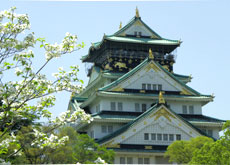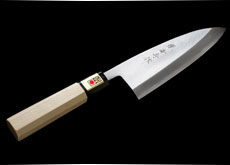Sakai Hocho or Japanese blades produced in Sakai

The Sakai Hocho or Sakai forged blades are the generic terms for the knives which are manufactured in Sakai city in Osaka in Japan.The history of the Sakai Hocho can be traced back to 1,600 years ago. Sakai city is the place where many ancient burial tombs including famous "Daisen Burial Tomb" which is the largest of its kind (generally known and described as the Mausoleum of Emperor Nintoku, the tomb of the emperor) are located. It is said that many swordsmiths started to live in Sakai, since the demand for the "spades" and "plows" which were used for the construction of ancient burial tombs became very high in Sakai.
Besides, guns and tobacco were introduced into Japan in the 16th century by the Portuguese. Once tobacco leaves
started being cultivated, the knives for cutting the tobacco leaves were in demand.
Then, the tobacco knives started being forged in Sakai for the first time.
Then in the Edo period, the knives forged in Sakai were sold nationwide as monopoly goods with the special
seal of approval and guarantee of their quality called "Sakai Kiwame (literally, hallmark)" awarded by
the Tokugawa Shogunate stamped on the knives. The Sakai Hocho or the Japanese blades produced in Sakai became
loved across the country for their blades that have very sharp edge and the guaranteed quality.
With the advent of the emergence of the Deba or pointed knife, wide variety of knives started being
forged one after another.
The Sakai Hocho or the Japanese blades produced in Sakai are characterized by its strong and sharp cutting edge.
It is said that most of Japanese professional chefs are using the Sakai Hocho today.

The Sakai Hocho or the Japanese blades produced in Sakai are being manufactured based on the similar manufacturing process as Japanese swords ("Katana"). However, there is extremely big constraint in the manufacturing process of Japanese swords as it is not allowed to change its traditional manufacturing process. The steels called Tamahagane (literally "jeweled steel") refined in foot bellows are forged by smithing to shape into Japanese swords. However, there is no fundamental performance improvement such as sharpened edges, harder blades and stronger resistance to rust allowed for them. In this respect, since the manufacturing method of the materials being used in kitchen knives as well as their forging process have undergone evolution, it is said that the performance of kitchen knives is actually higher than that of Japanese swords.
The Sakai Hocho or the Japanese blades produced in Sakai are characterized by its manufacturing method where
bare metals (the metals which serve as the basis for the knives) and metal blades (the metals for cutting things)
are forged and welded (the method of joining metals through the heating and hitting by hammers).
Being manufactured by joining hard and soft metals together, the Sakai Hocho become very sharp and tough.



